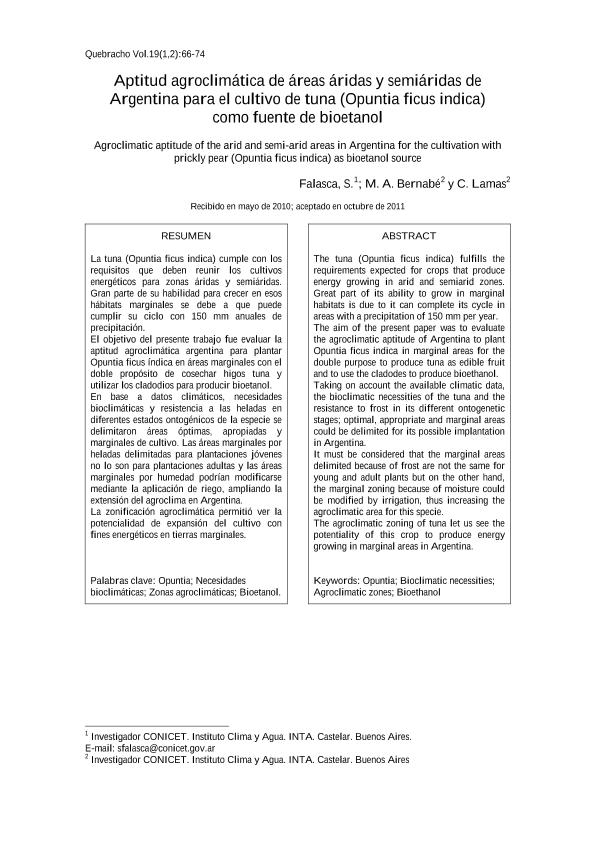Artículo
La tuna (Opuntia ficus indica) cumple con los requisitos que deben reunir los cultivos energéticos para zonas áridas y semiáridas. Gran parte de su habilidad para crecer en esos hábitats marginales se debe a que puede cumplir su ciclo con 150 mm anuales de precipitación. El objetivo del presente trabajo fue evaluar la aptitud agroclimática argentina para plantar Opuntia ficus índica en áreas marginales con el doble propósito de cosechar higos tuna y utilizar los cladodios para producir bioetanol. En base a datos climáticos, necesidades bioclimáticas y resistencia a las heladas en diferentes estados ontogénicos de la especie se delimitaron áreas óptimas, apropiadas y marginales de cultivo. Las áreas marginales por heladas delimitadas para plantaciones jóvenes no lo son para plantaciones adultas y las áreas marginales por humedad podrían modificarse mediante la aplicación de riego, ampliando la extensión del agroclima en Argentina. La zonificación agroclimática permitió ver la potencialidad de expansión del cultivo con fines energéticos en tierras marginales. The tuna (Opuntia ficus indica) fulfills the requirements expected for crops that produce energy growing in arid and semiarid zones. Great part of its ability to grow in marginal habitats is due to it can complete its cycle in areas with a precipitation of 150 mm per year. The aim of the present paper was to evaluate the agroclimatic aptitude of Argentina to plant Opuntia ficus indica in marginal areas for the double purpose to produce tuna as edible fruit and to use the cladodes to produce bioethanol. Taking on account the available climatic data, the bioclimatic necessities of the tuna and the resistance to frost in its different ontogenetic stages; optimal, appropriate and marginal areas could be delimited for its possible implantation in Argentina. It must be considered that the marginal areas delimited because of frost are not the same for young and adult plants but on the other hand, the marginal zoning because of moisture could be modified by irrigation, thus increasing the agroclimatic area for this specie. The agroclimatic zoning of tuna let us see the potentiality of this crop to produce energy growing in marginal areas in Argentina.
Aptitud agroclimática de áreas áridas y semiáridas de Argentina para el cultivo de tuna (Opuntia ficus indica) como fuente de bioetanol
Título:
Agroclimatic aptitude of the arid and semi-arid areas in Argentina for the cultivation with prickly pear (Opuntia ficus indica) as bioetanol source
Fecha de publicación:
06/2011
Editorial:
Universidad Nacional de Santiago del Estero. Facultad de Ciencias Forestales
Revista:
Quebracho
ISSN:
0328-0543
Idioma:
Español
Tipo de recurso:
Artículo publicado
Clasificación temática:
Resumen
Archivos asociados
Licencia
Identificadores
Colecciones
Articulos(SEDE CENTRAL)
Articulos de SEDE CENTRAL
Articulos de SEDE CENTRAL
Citación
Falasca, Silvia Liliana; Bernabé, María Angélica; Lamas, María del Carmen; Aptitud agroclimática de áreas áridas y semiáridas de Argentina para el cultivo de tuna (Opuntia ficus indica) como fuente de bioetanol; Universidad Nacional de Santiago del Estero. Facultad de Ciencias Forestales; Quebracho; 19; 2; 6-2011; 66-74
Compartir




